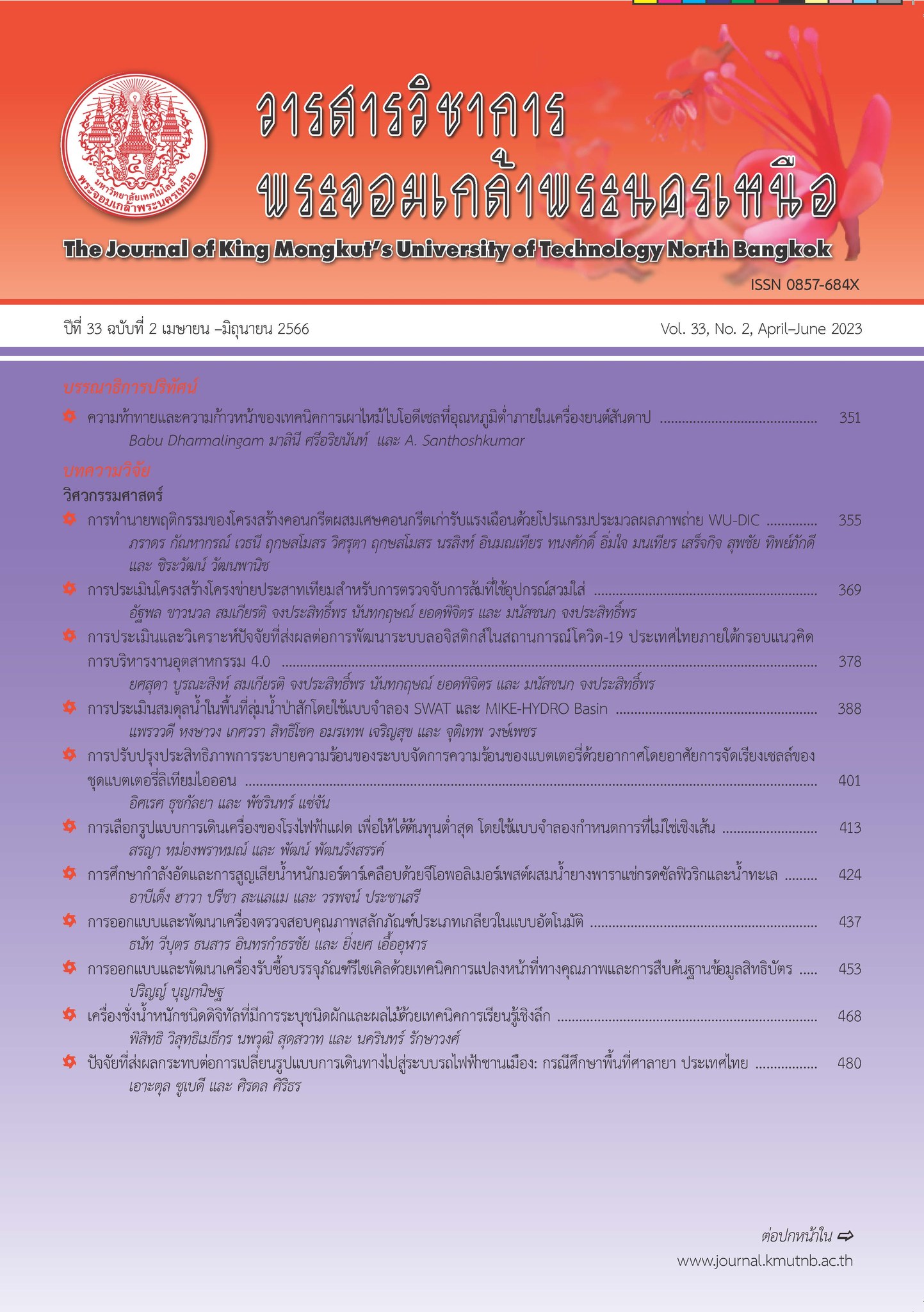การศึกษากำลังอัดและการสูญเสียน้ำหนักมอร์ตาร์เคลือบด้วยจีโอพอลิเมอร์เพสต์ผสมน้ำยางพาราแช่กรดซัลฟูริกและน้ำทะเล
Main Article Content
บทคัดย่อ
โครงสร้างพื้นฐานที่เป็นโครงสร้างคอนกรีตเสริมเหล็ก เช่น สะพาน ท่าเรือ ถนนคอนกรีต และอาคารต่าง ๆ ในประเทศกำลังพัฒนาที่มีอายุมากกว่าครึ่งศตวรรษ โครงสร้างคอนกรีตเสริมเหล็กที่ตั้งอยู่บริเวณน้ำทะเลหรือใกล้เคียงน้ำทะเลจะมีความเสียหายเนื่องจากปริมาณคลอไรด์สูงและซัลเฟต จีโอพอลิเมอร์เป็นวัสดุที่ราคาไม่แพง ซึ่งสามารถนำไปประยุกต์ใช้กับการเคลือบคอนกรีตเพื่อป้องกันการเกิดสนิมในเหล็ก การออกแบบอัตราส่วนผสมจีโอพอลิเมอร์เพสต์ในการเคลือบซีเมนต์มอร์ต้าร์ได้เตรียมจากดินขาวเผาและสารอัลคาไลน์ จีโอพอลิเมอร์เพสต์มีสารอัลคาไลน์เป็นอัตราส่วนผสม 1.0 ,0.75 และ 0.6 และใช้น้ำ 0.2 ,0.3 และ 0.4 โดยน้ำหนัก มีการเคลือบ 1 และ 2 ชั้น ใช้น้ำยางพาราแทนที่ดินขาวเผาร้อยละ 0.5, 1, 3, 5 และ 10 โดยน้ำหนัก ตัวอย่างจีโอพอลิเมอร์บ่มที่อุณหภูมิ 80 องศาเซลเซียส และบ่มที่อุณหภูมิห้องเป็นเวลา 24 ชั่วโมง ทดสอบกำลังอัดและการสูญเสียน้ำหนักเมื่อแช่ในสารละลายกรดซัลฟูริก และการสูญเสียน้ำหนักเมื่อแช่น้ำทะเลจนถึงอายุ 28, 56 และ 90 วัน จากผลการทดสอบพบว่าตัวอย่างที่เคลือบด้วยจีโอพอลิเมอร์สามารถป้องกันและลดการสูญเสียน้ำหนักได้ในทุกอัตราส่วนผสม เมื่อเทียบกับตัวอย่างที่ไม่ผ่านการเคลือบ
Article Details

อนุญาตภายใต้เงื่อนไข Creative Commons Attribution-NonCommercial-NoDerivatives 4.0 International License.
บทความที่ลงตีพิมพ์เป็นข้อคิดเห็นของผู้เขียนเท่านั้น
ผู้เขียนจะต้องเป็นผู้รับผิดชอบต่อผลทางกฎหมายใดๆ ที่อาจเกิดขึ้นจากบทความนั้น
เอกสารอ้างอิง
Marine and Coastal Resources Research and Development Institute. (2019). Coral map 2019. [Online]. Available: https://www.dmcr. go.th/detailLib/4925
T. Cheewaket, C. Jaturapitakkul, and W. Chalee, “Effect of fly ash on chloride penetration ad compressive strength of reclycled and natural aggregate concrete under 5-year exposure in marine environment,” The Journal of KMUTNB, vol. 29, no. 1, pp. 112–123, 2019 (in Thai).
L. Y. Ponhsampatea, T. Cheewaket, and W. Chalee, “Chloride penetration and steel corrosion of concrete containing palm oil fuel ash under 5-year exposure in marine environment,” The Journal of KMUTNB, vol. 28, no. 1, pp. 23–36, 2018 (in Thai).
T. Bakharev, “Resistance of geopolymer materials to acid attack,” Cement and Concrete Research, vol. 35, no. 4, pp. 658–670, 2005.
S. Hanjitsuwan, T. Phoo-ngernkham, L. Y. Li, N. Damrongwiriyanupap, and P. Chindaprasirt, “Strength development and durability of alkaliactivated fly ash mortar with calcium carbide residue as additive,” Construction and Building Materials, vol. 162, pp. 714–723, 2018.
U. Rattanasa, “Coating materials for concrete prepared from alkali-activated fly ash for application in acid condition,” Faculty of Science, Burapha University, Thailand, 2015.
A. M. Aguirre-Guerrero, R. A. Robayo-Salazar, and R.M. Gutiérrez, “A novel geopolymer application: Coatings to protect reinforced concrete against corrosion,” Applied Clay Science, vol. 137, pp. 437–446, 2017.
A. Hawa. D. Tonnayopas, W. Prachasaree, and P. Taneerananon, “Properties of metakaolin based geopolymer binder used in repair of concrete pavement,” Princess of Naradhiwas University Journal, vol. 5, no. 2, pp. 37–47, 2013 (in Thai).
A. Hawa and W. Prachasaree, “Metakaolin based geopolymer,” Princess of Naradhiwas University Journal, vol. 8, no. 1, pp. 155–167, 2016 (in Thai).
Standard Test Method for Compressive Strength of Hydraulic Cement Mortars (Using 2-in. or [50-mm] Cube Specimens), ASTM C109/ C109M-07, 2008.
V. Sata, A. Sathonsaowaphak, and P. Chindaprasirt, “Resistance of lignite bottom ash geopolymer mortar to sulfate and sulfuric acid attack,” Cement and Concrete Composites, vol. 34, no. 5, pp. 700-708, 2012.
S. Alonso and A. Palomo, “Alkaline activation of metakaolin and calcium hydroxide mixtures: Influence of temperature, activator concentration and solids ratio,” Materials Letters, vol. 47, no. 1-2, pp. 55-62, 2001.
K. Somna, C. Jaturapitakkul, P. Kajitvichyanukul, and P. Chindaprasirt, “NaOH-activated ground fly ash geopolymer cured at ambient temperature,” Fuel, vol. 90, no. 6, pp. 2118– 2124, 2011.
S. Hanjitsuwan, T. Phoo-ngernkham, and P. Chindaprasirt, “Influence of fineness of high calcium fly ash on properties of geopolymer paste,” KMUTT Research and Development Journal, vol. 36, no. 4, pp. 399–408, 2013 (in Thai).
P. Rovnaník, “Effect of curing temperature on the development of hard structure of metakaolin-based geopolymer,” Construction and Building Materials, vol. 24, no. 7 pp. 1176– 1183, 2010.
K. Sothonchaivit, W. Tangchirapat, T. Cheewaket, and C. Jaturapitakkul, “A study of compressive strength and sulfuric acid and magnesium sulfate resistances of geopolymer mortar made from calcium fly ash blended with high calcium fly ash,” Journal of Thailand Concrete Association, vol. 6, no. 2, pp. 58-66, 2018 (in Thai).
A. Hawa, W. Prachasaree, and D. Tonnayopas, “Effect of water-to-powder ratios on the compressive strength and microstructure of metakaolin based geopolymers,” Indian Journal of Engineering and Materials Sciences, vol. 24, no. 6, pp. 499–506, 2017.
S. Sikora, E. Gapys, B. Michalowski, T. Horbanowicz, and M. Hynowski, “Geopolymer coating as a protection of concrete against chemical attack and corrosion,” in Proceedings E3S Web of Conferences 49, 2018.
P. Krammart, I, Sirisawat, W. Saengsoy, and S. Tangtermsirikul, “Sulfate resistance of mortars with limestone powder,” Journal of Thailand Concrete Association, vol. 2, no. 2, pp. 17–24, 2014 (in Thai).
D. Bondar, C. J. Lynsdale, N. B. Milestone, and N. Hassani, “Sulfate resistance of alkali activated pozzola,” International Journal of Concrete Structures and Materials, vol. 9, no. 2, pp. 145–158, 2015.

